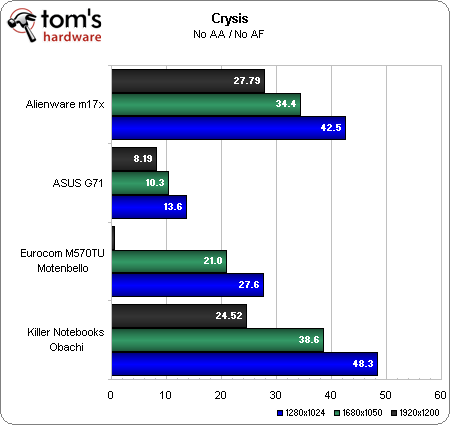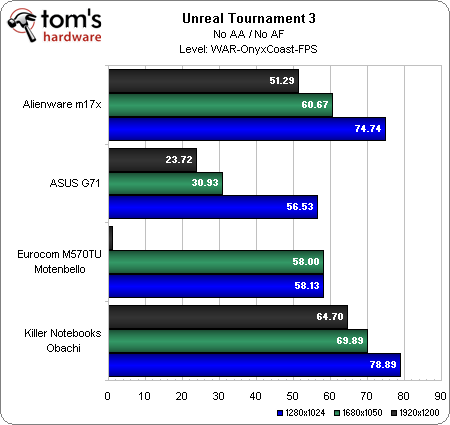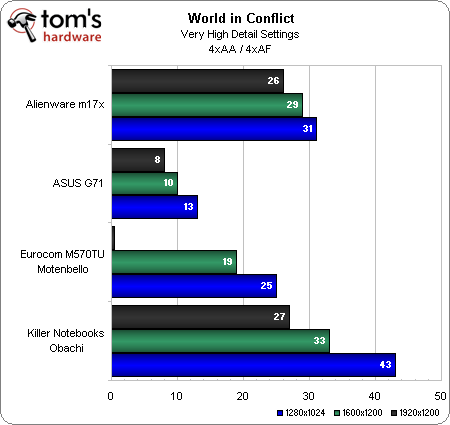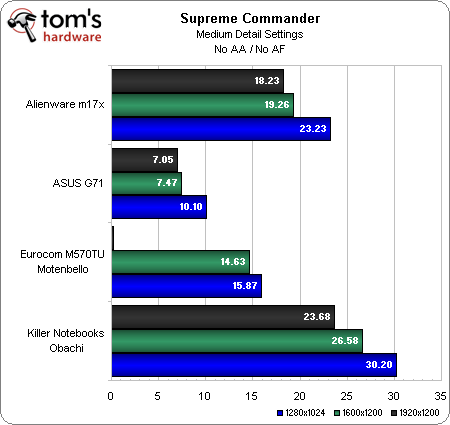SLI & Centrino 2: Gaming Laptops Battle
Benchmark Results: Gaming

Killer Notebooks’ Odachi scores a first-place finish at 1280x1024 and 1680x1050, as Alienware’s m17x pulls ahead at 1920x1200. It’s of little consequence, though, as we’d only really want to play Crysis at its High quality setting at 1280x1024. Even with the benefit of SLI, gaming at 1920x1200 is not going to be possible.
The Eurocom and ASUS notebooks each demonstrate unplayable frame rates.

Performance improves across the board as we shift to Unreal Tournament 3, where even ASUS’ GeForce 9700M GT manages playable performance at 1280x1024. The higher-end SLI configurations remain playable all the way through 1920x1200. The single 9800M GT in Eurocom’s Montebello is good enough at either 12x10 or 16x12, but because the 15.4” display can’t do 19x12, there are no results for it.

While its genre isn’t really known for bringing graphics cards to their knees, World in Conflict is actually a fairly demanding DirectX 10 benchmark. The Odachi is playable at 1280x1024, but both SLI-equipped notebooks fall off pretty quickly after that. Eurocom’s Montebello struggles a bit at its two available resolutions, and the G71 is unplayable across the board.

Once again, Killer Notebooks’ configuration wins out. In this case, much of the performance delta is likely attributable to the Odachi’s quad-core processor, which is taken advantage of in Supreme Commander. As we’ve seen throughout, the non-SLI notebooks have a much harder time coping with modern titles, even with the details dialed down, as they are here.
Get Tom's Hardware's best news and in-depth reviews, straight to your inbox.
-
kitsilencer From a money point of view, it's never going to make sense buying a gaming laptop. Scaled down performance and inability to upgrade are issues.Reply
But it sure as hell feels good having one ^___^ -
neiroatopelcc http://www.tomshardware.com/reviews/gaming-notebook-roundup,2023-6.htmlReply
"shipped the system with a 64-bit copy of Vista Ultimate (Alienware included x32 Home Premium)." -
ap90033 4 Grand? Are you guys nuts? I would say that right there would rule out about 90% of us normal gmaers..Reply
Besides the gaming scores looked weak imo..
I personally thought it was a better idea to go get a Gateway P7811FX with a single Geforce 9800GTS. It plays Call of Duty at 1920x1200 max settings around 50FPS. AND it cost me ONLY $1249 (Plus Best Buy let me pick any game I wanted for FREE!) -
agree with kitsilencer, gaming laptop is never practical.Reply
even with a beast graphics card, you'd be pretty hard to get more than 2 hours of shitty performance.
get a gaming desktop and perhaps an EEE or iPhone for travelling. my iPhone has 20+ games and enough media (don't forget TV connector for watching films in hotels) to keep me busy for more than one week away from my gaming rig. -
ap90033 Not true my "Gmaing Laptop" is great at LAN Parties and I play it for 6-8 Hours straight there...Reply
I think maybe you had a bad experience with a laptop that claimed to be a "gaming" laptop. I bought one before like that and it have an 8600M Geforce and it Sucked bad... If you get a good laptop with say a 9800gts or so you would be suprised... -
GlItCh017 ap900334 Grand? Are you guys nuts? I would say that right there would rule out about 90% of us normal gmaers..99.90%Reply -
ap90033 PS gaming laptops hold value much better than desktops. I had one I paid 1250 for, had it for a year, then sold it for $1100 and bought the newer "upgraded" model that just came out for $1250. I got an Upgraded CPU (From Core 2 1.67 GHZ to Core 2 Centrino 2 2.26 GHZ), Memory (from 3 Gigs DDR2 667MHZ to 4 Gigs DDR3 1066MHZ), Hard Drive (faster), Video Card (from 8800gts to 9800GTS), Screen (from 1440x800 to 1920x1200) and OS (From 32 bit to 64 bit). Not bad upgrade for $150 or so!Reply
